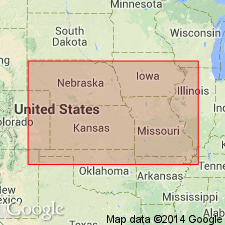
- Usage in publication:
-
- Stark shale member*
- Modifications:
-
- Named
- Dominant lithology:
-
- Shale
- AAPG geologic province:
-
- Forest City basin
Summary:
Pg. 99, 102, 103. [See also Moore (1932) entry under Dennis Formation.] Stark shale is proposed for the shale above Canville limestone and below Winterset limestone [all included as members of Dennis formation]. Its lower part is dark or black and carbonaceous, and upper part is commonly yellow, although the yellow upper part is not persistent. Traced by writer from Kansas City, Missouri, to Dennis, Labette County, Kansas. Its easily distinguished from Galesburg shale by means of the black shale at its base, even though Canville limestone be not present, as is case at Kansas City. Thickness 8 to 11 feet. Age is Late Pennsylvanian (Missouri age). Report includes cross section.
Source: US geologic names lexicon (USGS Bull. 896, p. 2054-2055).
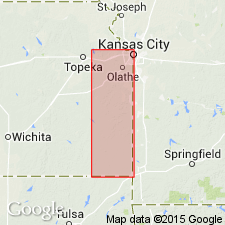
- Usage in publication:
-
- Stark shale member*
- Modifications:
-
- Principal reference
- AAPG geologic province:
-
- Forest City basin
Summary:
Pg. 133. Type locality: near Stark, Neosho Co., KS.
Source: US geologic names lexicon (USGS Bull. 896, p. 2054-2055).

- Usage in publication:
-
- Stark shale member*
- Modifications:
-
- Overview
- AAPG geologic province:
-
- Forest City basin
Summary:
Pg. 92. Stark shale member of Dennis limestone of Bronson group. North of point in Linn County, where Canville limestone disappears, Stark shale member of Dennis formation rests on Galesburg shale, but because lower part of Stark member is black fissile shale (1 to 3 feet thick) it is easy to separate Stark and Galesburg shales. In southern Kansas, where Canville is missing, the absence of black platy shale at horizon of Stark member makes it impossible to recognize Stark shale, and upper boundary of Galesburg shale is extended up to base of Winterset limestone. The upper part of Stark shale consists of gray of buff calcareous clay shale 2 to 5 feet thick. At Kansas City total thickness of Stark shale is 4 feet. Age is Late Pennsylvanian (Missouri age). Jewett is author of name.
Source: US geologic names lexicon (USGS Bull. 896, p. 2054-2055); GNC KS-NE Pennsylvanian Corr. Chart, sheet 2, Oct. 1936.
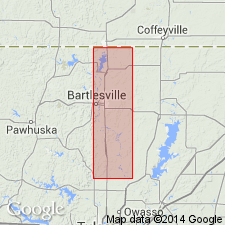
- Usage in publication:
-
- Stark shale member
- Modifications:
-
- Revised
- AAPG geologic province:
-
- Forest City basin
Summary:
Pg. 43. See also, 1952, Oklahoma Geol. Survey Bull., no. 69, p. 59. In Oklahoma, considered member of Hogshooter formation. Overlies Canville limestone member; underlies Winterset limestone. Thickness 3 to 10 feet.
Source: US geologic names lexicon (USGS Bull. 1200, p. 3709).
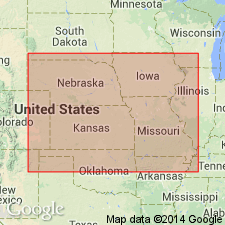
- Usage in publication:
-
- Stark shale member*
- Modifications:
-
- Overview
- AAPG geologic province:
-
- Forest City basin
Summary:
Pg. 2031 (fig. 4). Stark shale member of Dennis formation. Overlies Canville limestone member; underlies Winterset limestone member. This is classification agreed upon by State Geological Survey of Iowa, Kansas, Missouri, Nebraska, and Oklahoma, May 1947.
Source: US geologic names lexicon (USGS Bull. 1200, p. 3709).
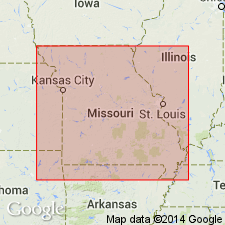
- Usage in publication:
-
- Stark shale member
- Modifications:
-
- Overview
- AAPG geologic province:
-
- Forest City basin
Summary:
Pg. 11-12. Galesburg formation redefined to exclude Canville limestone and Stark shale. Latter units included in Dennis formation.
Source: US geologic names lexicon (USGS Bull. 1200, p. 3709).
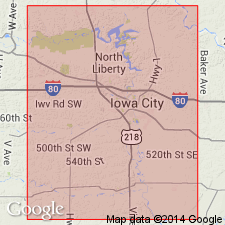
- Usage in publication:
-
- Stark shale member
- Modifications:
-
- Areal extent
- AAPG geologic province:
-
- Iowa shelf
Summary:
Pg. 421. Thickness about 4 feet near Winterset, [Madison County], Iowa.
Source: US geologic names lexicon (USGS Bull. 1200, p. 3709).
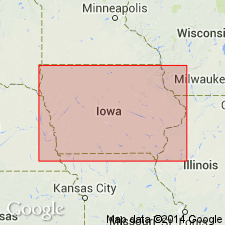
- Usage in publication:
-
- Stark shale member
- Modifications:
-
- Areal extent
- AAPG geologic province:
-
- Cherokee basin
Summary:
Pg. 27, fig. 5. Stark shale member of Dennis limestone. Dark gray and fossiliferous at top; black fissile at base. Thickness 1.8 to 2.9 feet in Madison County; 5 feet in cores from Pottawattamie County. Overlies Canville limestone member; underlies Winterset limestone member. Age is Late Pennsylvanian (Missourian).
Source: US geologic names lexicon (USGS Bull. 1200, p. 3709).
For more information, please contact Nancy Stamm, Geologic Names Committee Secretary.
Asterisk (*) indicates published by U.S. Geological Survey authors.
"No current usage" (†) implies that a name has been abandoned or has fallen into disuse. Former usage and, if known, replacement name given in parentheses ( ).
Slash (/) indicates name conflicts with nomenclatural guidelines (CSN, 1933; ACSN, 1961, 1970; NACSN, 1983, 2005, 2021). May be explained within brackets ([ ]).

